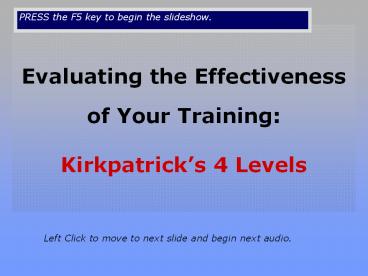Evaluating the Effectiveness of Leadership Development Program PowerPoint PPT Presentation
1 / 17
Title: Evaluating the Effectiveness of Leadership Development Program
1
PRESS the F5 key to begin the slideshow.
Evaluating the Effectiveness of Your Training
Kirkpatricks 4 Levels
Left Click to move to next slide and begin next
audio.
2
Is the training program a quality program? Does
it follow...
- The Principles and Process of Good Training
Development Delivery - Training Needs Assessment
- Establish Learning Objectives
- Content
- Delivery
- Evaluation
3
National Institute of Corrections
ModelInstructional Theory Into Practice (ITIP)
Training Cycle
Needs Assessment
Evaluation
Set Performance Objectives
Deliver Training
Design Training
Train Instructors
Pilot Test
Revise
Evaluation
4
Assessment of Training Needs
- In order to be effective, a training must be
based on the needs of the trainees, and the
needs or goals of the organization. - Identify The Gap -- between what skills
employees actually have --and what they should be - Who should determine need for training?
Management, trainees themselves, co-workers,
specialists in the field,
5
Needs Assessment Sample Questionnaire
5 3 1 2
6
Establishing Learning Objectives
- Skills-based or competency-based objectives
- Knowledge-Based objectives more likely to
include what the learner will understand or be
able to explain - Attitudes individual attitudes needed to fully
perform
7
Learning Objectives
- Competency goals should be
- Behaviorally anchored
- Observable
- Forward-thinking
- Discrete
- User-friendly
- Example Supervisor frequently gives accurate and
specific feedback to subordinates about their
performance.
Hackett
8
Training Content
- Does content meet best practices established by
leading organizations in the field of juvenile
confinement? (NIC, NJDA, CJCA, NCCHC) - Does the content cover the needs of staff?
- Does it accurately reflect local policies and
procedures? - Is the content timely? Does it reflect current
research and theory?
9
Training Delivery
- Meets the needs of all learning styles
active/kinetic, visual, social, audio - Covers all parts of the learning cycle
perceiving, reflecting, applying, creating - Organized presentation
- Positive learning environment
- Empathetic, knowledgeable, professional trainers
- Et cetera
10
Training Evaluation Does the training actually
work?
- Does the training leave your staff feel more
motivated, more confident, more knowledgeable? - Does the training affect the way staff do their
job? How are youth affected by the change? - Is it causing the change in staffs performance
that we want? To the degree that we want?
11
Evaluating Training Effectiveness Kirkpatricks
4 levels
- Level 4 Results
Level 3 Behavior Change
Level 2 Learning
Level 1 Reaction
12
Level 1 Evaluation Reaction
- Training Evaluation
- Did you like this training?
- Was the material relevant to your job?
- Was the trainer knowledgeable?
- What do you think was the most important thing
you learned? - Are the handouts helpful?
- Comments _______________
A positive reaction does not guarantee learning,
but a negative reaction almost certainly reduces
its possibility.
13
Level 2 Evaluation Learning
Other methods can be less formal, such as trainer
observations during practice, team assessments,
or self-assessments.
14
Level 3 Evaluation Behavior Change on the Job
- Guidelines
- Use a control group if practical
- Evaluate both before and after the training if
possible - Survey and/or interview people who can observe
the behavior - Get 100 percent response or a random sampling
- Repeat the evaluation at appropriate times
including after allowing a time lapse
15
Level 3 Evaluation continued Example questions
16
Level 4 Evaluation Organizational Impact
- Measures broad-based changes in areas that are
important to the agency as a whole, such as - decreased legal costs
- Safety improvements
- Increased arrests
- Compare measures before and after training.
- Complicated and Expensive
17
Sample results of a Level 4 Evaluation
- Change in use of physical restraints as measure
of Behavior Management training
Number of incidents

